NRAO eNews
Volume 9, Issue 1
27 January 2016
Call for Abstracts: NAASC Workshop on Molecular Gas in Galactic Environments
The National Radio Astronomy Observatory (NRAO) – North American ALMA Science Center (NAASC) is delighted to announce a Call for Abstracts for the 2016 NAASC Workshop on Molecular Gas in Galactic Environments to be held 4 – 7 April 2016 in Charlottesville, Virginia, USA.
Registration and abstract submission are now available via the 2016 NAASC Workshop website – the deadline is 15 February 2016.
The spectral line sensitivity and spectral grasp of the Atacama Large Millimeter/submillimeter Array (ALMA) have resulted in the identification and imaging of more than 40 molecules outside the Milky Way. This international Workshop will focus on the character of the molecular gas in the varied environments in which these molecules are found beyond our Galaxy and will bring together ALMA, Very Large Array (VLA) and Green Bank Telescope users and potential users of future facilities – a next-generation VLA, the James Webb Space Telescope, the Thirty Meter Telescope, etc. – to consider what capabilities or upgrades to these instruments might best facilitate the study of extragalactic molecules.
Major topics of discussion at this NAASC Workshop will include:
- Exploring the relationship between molecular distributions and physical processes in those galaxies
- Investigating the roles of molecular variation in extreme metallicity environments
- Examining the existence and cause of isotopic gradients within galaxies
- Scrutinizing variations in molecular excitation, both rotational and vibrational
- Seeking evidence for and causes of molecular abundance gradients
- Identifying molecules useful as probes of nuclear infall and outflow
- Determining the prospects of molecules as probes of black hole masses.
Confirmed invited speakers for this Workshop include:
- Francesco Costagliola (Chalmers, Onsala Space Observatory)
- Nanase Harada (Academia Sinica, Taiwan)
- Christian Henkel (Max Planck Institute for Radio Astronomy)
- Leslie Hunt (INAF-Osservatorio Astrofisico di Arcetri)
- Takuma Izumi (University of Tokyo)
- Adam Leroy (Ohio State University)
- Sergio Martin (Joint ALMA Observatory)
- Gergö Popping (European Southern Observatory)
- Dominik Riechers (Cornell University)
- Nick Scoville (California Institute of Technology)
- Jean Turner (University of California, Los Angeles)
This four-day NAASC workshop will include several invited talks designed to guide the discussions of relevant questions to be addressed. Contributed abstracts will be solicited, and the Science Organizing Committee will select a subset for oral presentations, with the rest accepted as posters. Registration will include workshop materials, daily breakfast, breaks, and a welcome reception. An optional conference dinner will also be available.
Submissions by students and early-career researchers are especially encouraged. To promote their attendance, students will be offered a discounted registration rate and a free double-occupancy room in the Workshop hotel for the duration of the Workshop.
We look forward to seeing everyone in Charlottesville in April!
Half A Decade of ALMA: Cosmic Dawns Transformed

The sensitivity and spectral grasp of the Atacama Large Millimeter/submillimeter Array (ALMA) have revolutionized the study of the youngest structures in the Universe, from galaxy formation through the formation of stars and planets. ALMA has produced over 300 refereed papers with over 3000 citations at its four-year mark, reporting impressive and scientifically compelling results as the most sensitive and highest resolution millimeter/submillimeter interferometer in the world.
This international four-day conference will highlight ALMA results at the threshold of the array's fifth year of science operations and bring together researchers from around the world to motivate collaborations for ALMA Cycle 5. Science topics will include all fields of astronomy, from cosmology and galaxies in the distant Universe, nearby galaxies and the Galactic Center, the interstellar medium and star formation in our Galaxy, astrochemistry, circumstellar disks, exoplanets, solar system, stellar evolution, and the Sun.
The conference will feature invited and contributed talks as well as poster sessions. Early career researchers and students are particularly encouraged to attend.
Visit the conference website for additional information.
| Conference Timetable | |
|---|---|
| Date | Event |
| Mid March 2016 | Abstract submissions and Registration open |
| Mid May 2016 | Abstract submission close |
| Mid July 2016 | Preliminary program released |
| Mid August 2016 | Registration closes |
| 4 September 2016 |
Hotel Reservation deadline |
NRAO Live! Proposal Workshops Coming to an Auditorium Near You
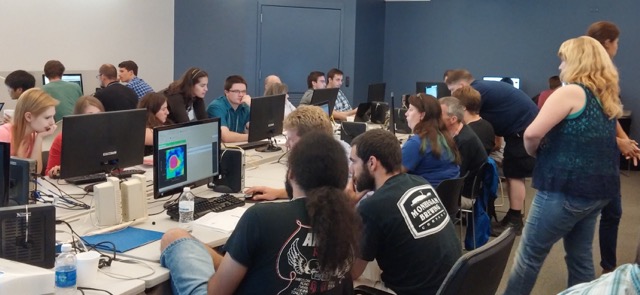
In advance of the ALMA Cycle 4 Call for Proposals, we will have a series of NRAO Live! events at a number of North American institutions. The goal of these events is to provide users with the knowledge they need to carry out cutting-edge scientific research using NRAO facilities. We are particularly interested in reaching new users, so no experience with radio astronomy is required to participate!
NRAO Live! events are one to two day workshops designed in cooperation with host institutions across North America, and participation is free. No registration fees will be charged. These events include science talks, an introduction to submillimeter interferometry, and hands-on workshops designed to assist you in proposal preparation, observation planning, and data reduction for ALMA Cycle 4. You will need to bring your laptop to participate in the hands-on sessions, and we will provide access to the free software that you can download, as well as the small dataset to be used in the demonstrations.
If you are interested in attending an NRAO Live! Proposal Workshop, have a look for the one nearest you from the list below:
| Date | Location |
|---|---|
| 18 – 19 February 2016 | McGill University, Montreal |
| 7 – 8 March | Boston University |
| 10 – 11 March | University of Texas – Austin, TX |
| 15 – 16 March | University of Wisconsin – Madison, WI |
| 31 March | Carnegie Observatories – Pasadena, CA |
5th VLA Data Reduction Workshop

With just under two months to go, the 5th Jansky Very Large Array (VLA) Data Reduction Workshop has only ~ 10 places left. If you would like to participate, we recommend that you register soon.
The main goal of this Workshop, which will be held from 14-18 March 2016, is to assist observers with the challenges of Jansky VLA Data Reduction posed by the increased flexibility and complexity of the instrument. NRAO staff will provide lectures on various topics of interest, and allow participants to reduce some fraction of their own data with local expert staff in attendance for consultation.
This is an advanced workshop, and unlike our summer Synthesis Imaging Workshops, is not intended for those who are new to radio interferometry. Prior experience with AIPS, CASA, or MIRIAD is required. As we will be using CASA as our main data reduction package, a working knowledge of CASA would be helpful.
To register, and for more information, please visit the Workshop web page.
We look forward to welcoming you to Socorro in March!
Upcoming Events

AAAS 2016: Planet Formation With Radio Eyes
Feb 13, 2016 | Washington, DC

NRC/NRAO Live! (McGill)
Feb 18 - 19, 2016 | Montreal, Canada

NRAO Live! (Boston)
Mar 7 - 8, 2016 | Boston, MA

NRAO Live! (Texas)
Mar 10 - 11, 2016 | Austin, TX

5th VLA Data Reduction Workshop
Mar 14 - 18, 2016 | Socorro, NM

NRAO Live! (Wisconsin)
Mar 15 - 16, 2016 | Madison, WI

NRAO Live! (Carnegie Observatories)
Mar 31, 2016 | Pasadena, CA

Molecular Gas in Galactic Environments
Apr 4 - 7, 2016 | Charlottesville, VA

Half a Decade of ALMA: Cosmic Dawns Transformed
Sep 20 - 23, 2016 | Indian Wells, CA
ALMA Program News
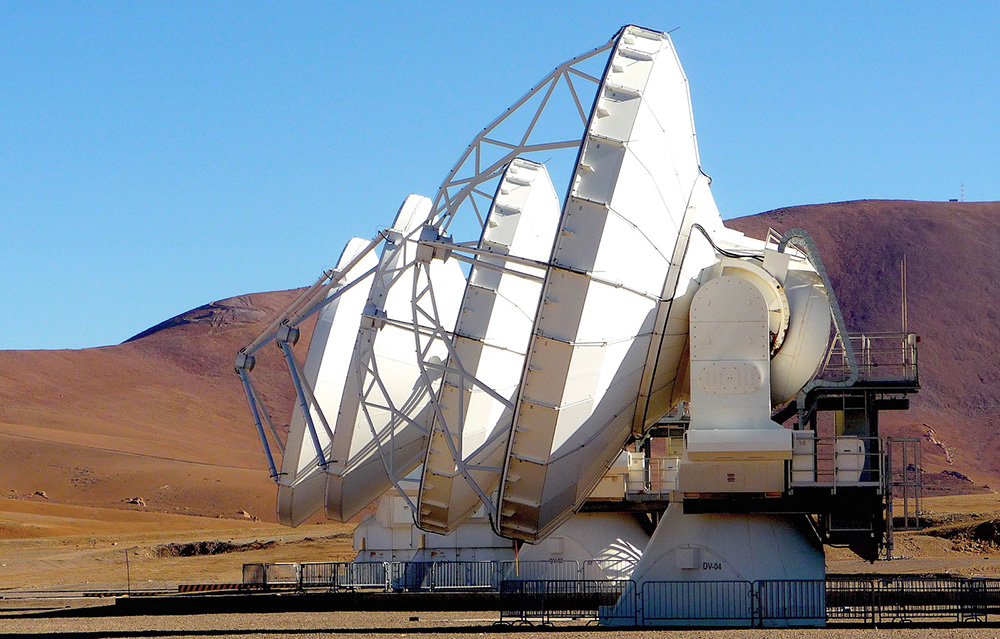
T. Burchell, ALMA (NRAO, ESO, NAOJ)
[click to enlarge]
Investigators using the Atacama Large Millimeter/submillimeter Array (ALMA) published 145 refereed papers in 2015 – nearly half of the total of 332 to date – reporting impressive and scientifically compelling results from the most sensitive and highest resolution millimeter/submillimeter interferometer in the world.
ALMA was reconfigured into its compact C36-1 configuration during December 2015 and has been conducting approved science projects since. ALMA will remain in this configuration through 30 January 2016, after which a program of maintenance and upgrades will commence during the expected period of poorer weather for high frequency observations. Science observations will resume in the C36-2 configuration beginning 1 March 2016, as detailed on the ALMA Status Page.
ALMA Science Verification Data Release
A new installment of ALMA Science Verification data was released in December 2015. This release contains IRAS16293-2422 spectral line observations in Band 4 (CH3CN, CH3OH) with the 12-m Array, demonstrating the Band 4 capability. Details of these and other datasets are available at the Science Verification web page.
ALMA Cycle 4
The ALMA Cycle 4 pre-announcement was released 10 December 2015. As described therein, it is expected that ALMA will participate as a phased element in some Global 3mm VLBI Array (GMVA) observations. There will likely be 30 – 40 ALMA dishes in the phased array. Any GMVA proposal requesting phased ALMA during Cycle 4 must be submitted via the NRAO Proposal Submission Tool (PST) at the 1 February 2016 deadline for the NRAO Semester 2016B Call for Proposals. A separate proposal to ALMA must also be submitted at the deadline for ALMA Cycle 4 proposals (see ALMA Science Portal). A Call for Proposals with detailed information on ALMA Cycle 4 will be issued 22 March 2016, with an anticipated deadline for proposal submission on 21 April 2016. Cycle 4 observing will take place October 2016 – September 2017.
International ALMA Science Conference
Abstract submission and registration will open for Half a Decade of ALMA: Cosmic Dawns Transformed, an international conference highlighting ALMA science. The conference will be held in Indian Wells, California, 20-23 September 2016. Science topics will include all fields of astronomy, from cosmology and galaxies in the distant Universe, nearby galaxies and the Galactic Center, the interstellar medium and star formation in our Galaxy, astrochemistry, circumstellar disks, exoplanets, solar system, stellar evolution, and the Sun.
Call for ALMA Development Studies
North America plans to issue a Call for Proposals for ALMA Development Studies in March 2016. Further details will be announced soon.
GBT Spectra Service Available
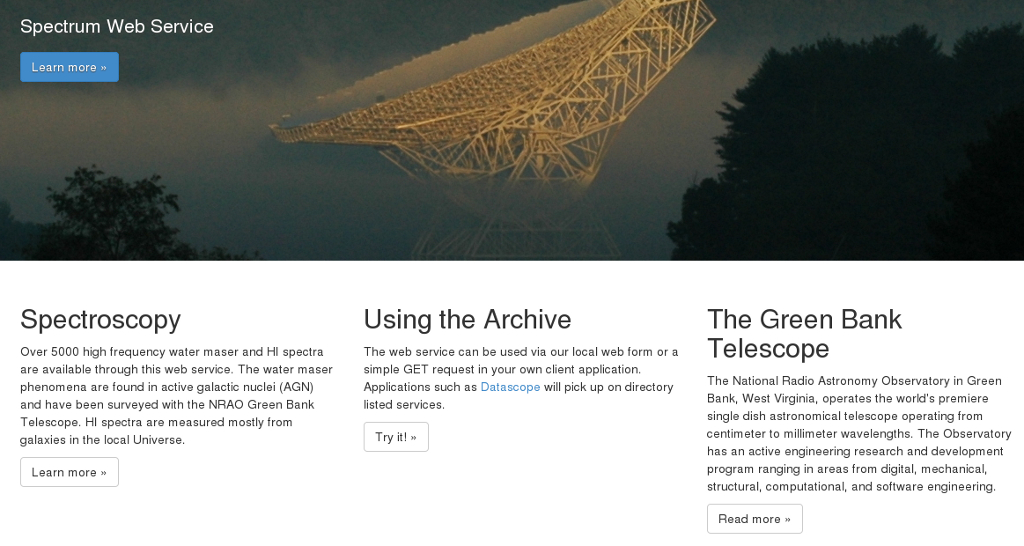
[click to enlarge]
New tools for retrieval of a subset of GBT spectra are available for proposers and other interested astronomers.
These services provide calibrated, processed data, including K-band extragalactic megamasers and nearby galaxy HI detections. The future addition of other spectra is also possible.
Queries sent from existing applications or simple web forms return XML tables that can be easily parsed in a user-written script. A description of the services, a form for generating queries, and an example Python script are available on-line.
NRAO Grote Reber Fellows at the Kissimmee AAS
The Grote Reber Doctoral Research Program at NRAO is jointly sponsored by the Observatory and by universities who wish their Ph.D. students to have a concentrated exposure to research in radio astronomy, instrumentation, or computational techniques in astrophysics. The duration of the fellowship is usually two years, during which the student works at one of the NRAO sites to complete their thesis research under the supervision of an NRAO scientist or engineer. Reber Fellows are paid a stipend and have access to NRAO's computing resources, and are also encouraged to attend one scientific meeting per year to present their Ph.D. research. Most recently, three of our Reber Fellows gave outstanding dissertation talks at the 227th meeting of the American Astronomical Society in Kissimmee, FL.
Loreto Barcos-Muñoz, a student at the University of Virginia working in Charlottesville, presented her research on "A High Resolution, Unobscured View of the Active Regions in (Ultra) Luminous Infrared Galaxies from a VLA 33 GHz Survey." Loreto works with Aaron Evans (UVA/NRAO) and Adam Leroy (Ohio State), among others.
Kristen M. Jones, also from the University of Virginia, gave a talk on her work with Mark Lacy (NRAO) and Danielle Nielsen (UW-Madison) on "The Environments of Obscured Quasars."
Bridget McEwen, a student at the University of New Mexico, currently working in Socorro, presented her thesis work on "Characterizing Supernova Remnant and Molecular Cloud Interaction Sites Using Methanol (CH3OH) Masers," a project she has undertaken with Ylva Pihlstrom (UNM) and Lorant Sjouwerman (NRAO).
Congratulations to these outstanding Ph.D. candidates!
NRAO Astronomer Recognized for Extraordinary Service
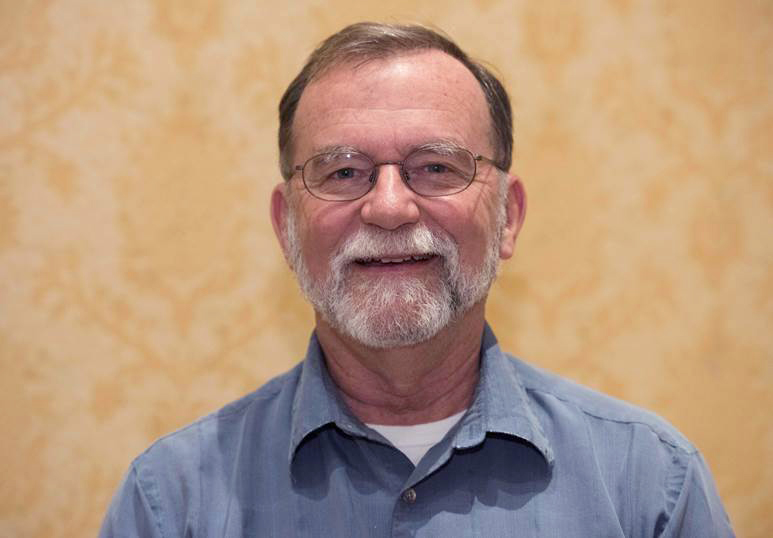
Rick Perley
[click to enlarge]
The American Astronomical Society (AAS) has awarded its prestigious George Van Biesbroeck Prize to Dr. Rick Perley of the National Radio Astronomy Observatory (NRAO) in Socorro, New Mexico. The society recognized Perley for his “tireless and unrelenting career-long service to the global astronomical community.”
The Van Biesbroeck Prize "honors a living individual for long-term extraordinary or unselfish service to astronomy, often beyond the requirements of his or her paid position." The AAS, with about 7,000 members, is the major organization of professional astronomers in North America.
The award cites Perley’s contributions “to the design, commissioning, and optimization of the world's premier radio telescope, the Very Large Array, and its recent reinvention as the Karl G. Jansky Very Large Array (VLA).” The citation notes that Perley’s efforts have been central to every major improvement in the VLA over that facility’s more than 35-year history.
Arriving at NRAO as the first postdoctoral research fellow at the VLA in 1977, Perley led efforts that produced some of the first iconic images that demonstrated the unparalleled capabilities of that telescope. In 1984, he founded a semiannual synthesis imaging school to teach astronomers from around the world how to effectively use the VLA. The AAS citation calls that school the “gold standard” of such training, and it has been emulated around the world.
Perley was NRAO’s Project Scientist for the decade-long VLA Expansion Project, completed in 2012, that transformed the VLA into a vastly more powerful scientific tool by bringing its electronic systems back to the state of the art. Noting those efforts, along with his enthusiastic advocacy for the VLA and radio astronomy, the AAS called him “the driving force behind one of the most powerful and productive telescopes in the world, at any wavelength, for close to four decades.”
“I’m very honored to receive this award, and greatly appreciate the American Astronomical Society’s recognition. It’s important to remember that the work they cite covers many years, and that many others have contributed greatly over those years to make the VLA the amazing scientific tool that it is,” Perley said.
“This award is very richly deserved, and we are proud that the wider astronomical community has recognized Rick’s efforts,” said NRAO Director Tony Beasley. “We all know just how hard he has worked to make the VLA such a valuable resource for the world’s astronomers, and it’s gratifying to see his contributions honored by our professional society,” Beasley added.
Perley will be presented with his prize at the AAS meeting in January of 2017.
Perley received bachelor’s and master’s degrees in physics from the University of British Columbia and his Ph.D. in astronomy from the University of Maryland, with the late Bill Erickson as his graduate advisor. He has worked at NRAO since 1977. He is a member of the American Astronomical Society, the International Radio Science Union, and the International Astronomical Union. In addition to his astronomical contributions, he has served as a long-time referee for soccer at many levels as well as volunteering as a judge for science fairs and Science Olympiad.
Perley is the third NRAO astronomer from Socorro to receive the Van Biesbroeck Award. Dr. Eric Greisen received the award in 2005 and Dr. Barry Clark was the recipient in 1991.
“Our observatory exists to serve the needs of the research community, and so we take distinct pride in noting that three of our scientists have received an honor that specifically recognizes extraordinary service to that community,” Beasley said.
NRAO at the Kissimmee AAS Meeting
Click through the slides below to see NRAO highlights from the January 2016 AAS meeting in Kissimmee, Florida.
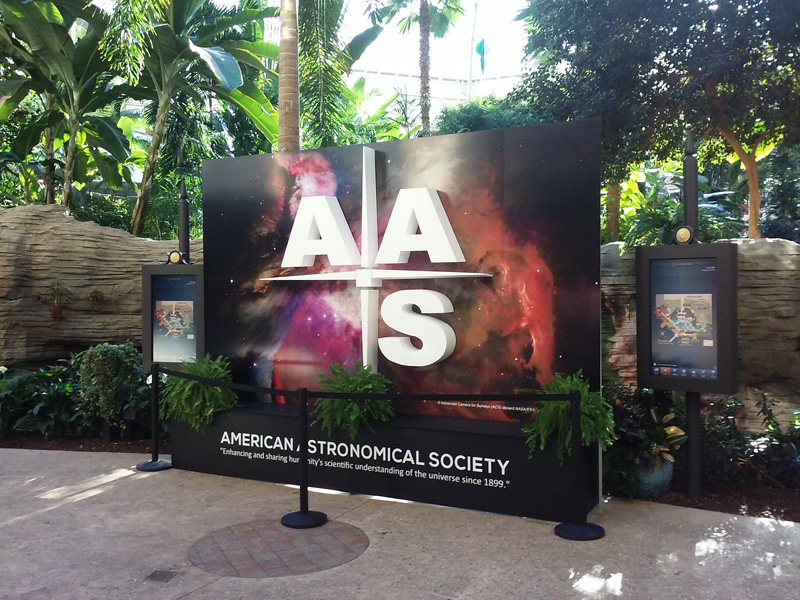 |
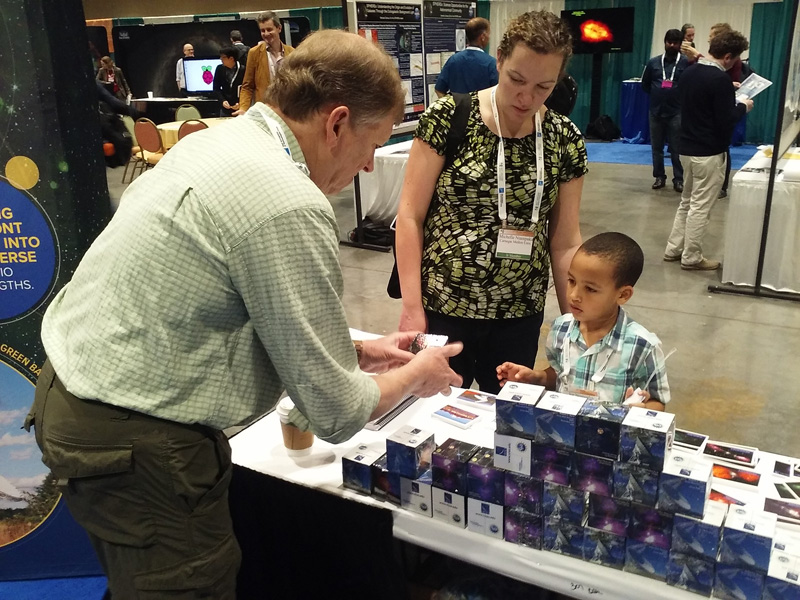 Jay Lockman demonstrates the NRAO Magic Cube for a young attendee. |
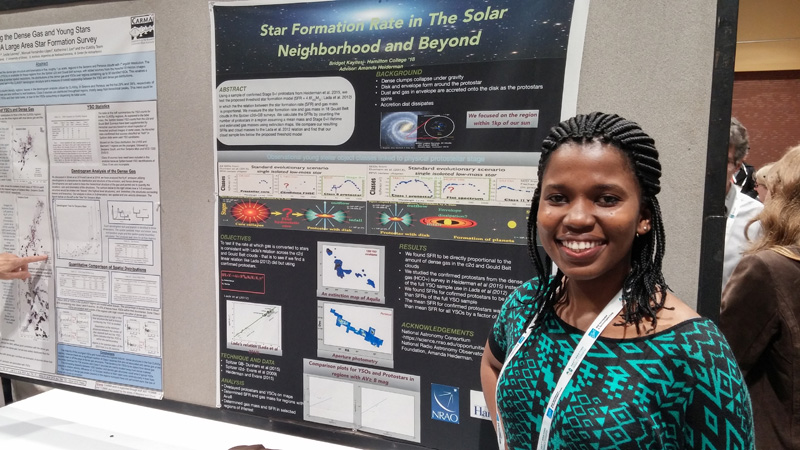 Bridget Kayitesi (Hamilton) presenting her NRAO Summer Student program research at a Kissimmee AAS meeting poster session. |
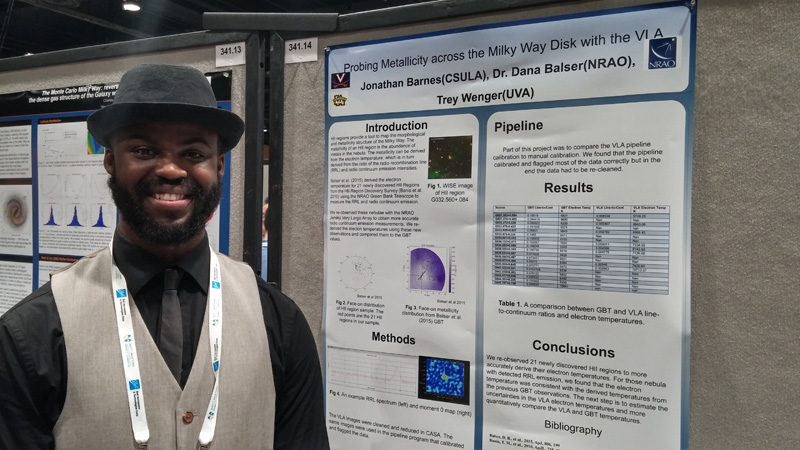 Jonathan Barnes (CSULA) presenting his NRAO Summer Student program research at a Kissimmee AAS meeting poster session. |
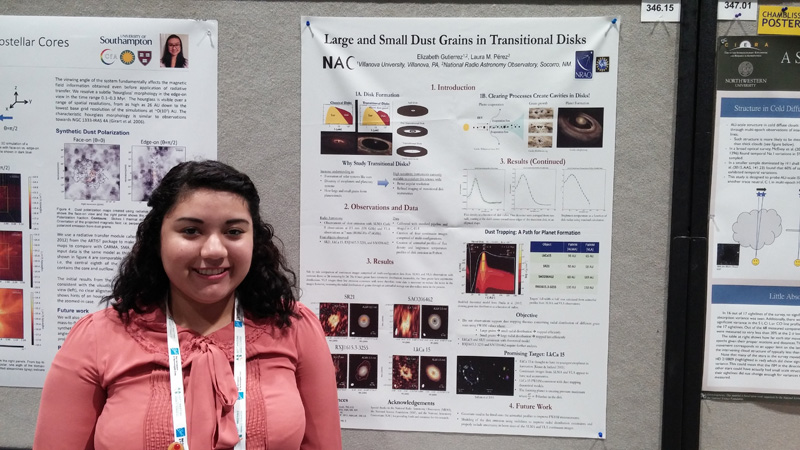 Elizabeth Gutierrez (Villanova) presenting her NRAO Summer Student program research at a Kissimmee AAS meeting poster session. |
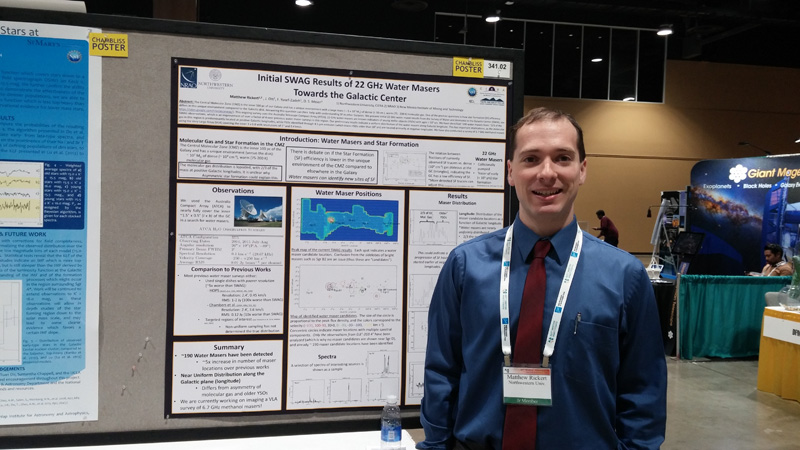 Matthew Rickert (Northwestern) presenting his NRAO Summer Student program research at a Kissimmee AAS meeting poster session. |
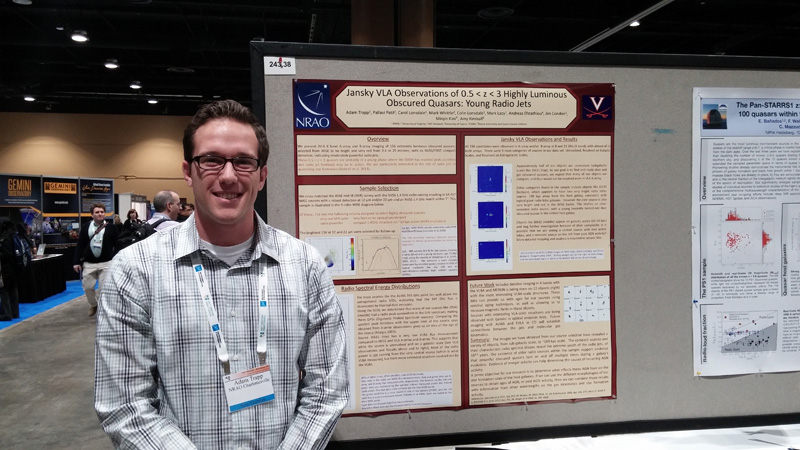 Adam Trapp (Virginia) presenting his NRAO Summer Student program research at a Kissimmee AAS meeting poster session. |
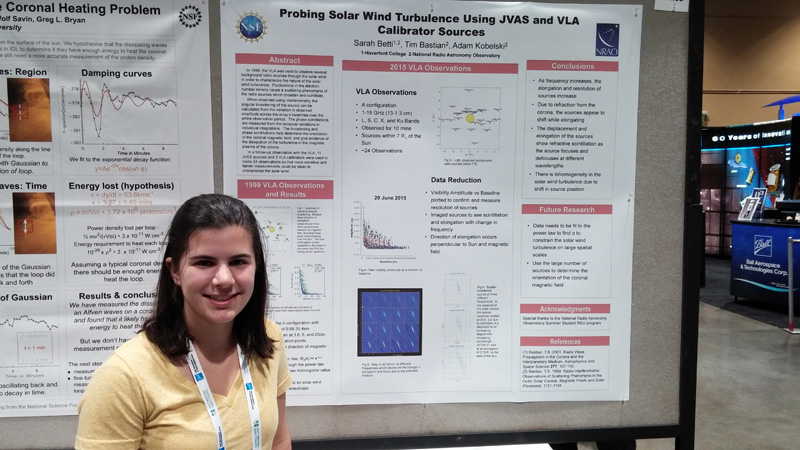 Sarah Betti (Haverford) presenting her NRAO Summer Student program research at a Kissimmee AAS meeting poster session. |
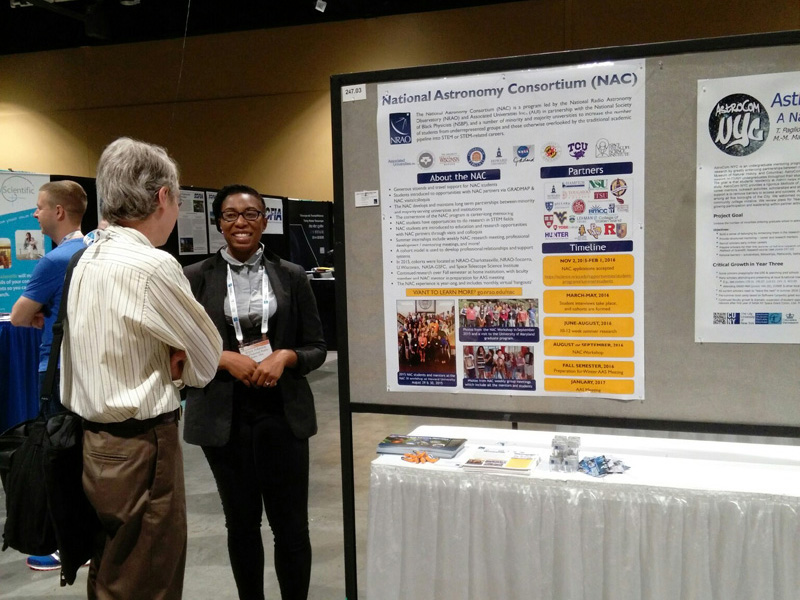 Joyce Johnson (Human Resources) presented a poster describing the National Astronomy Consortoium (NAC) student program. |
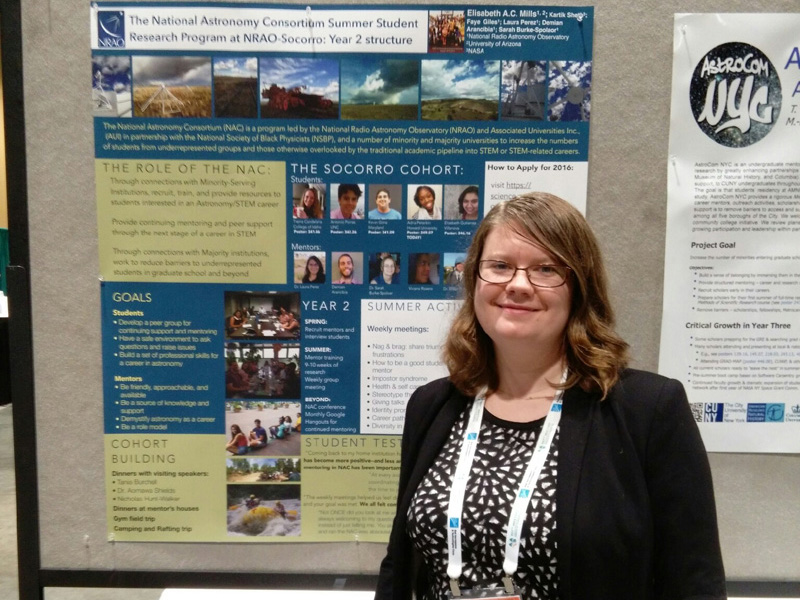 Elisabeth Mills (Jansky Fellow) presented a poster describing the National Astronomy Consortoium (NAC) student program. |
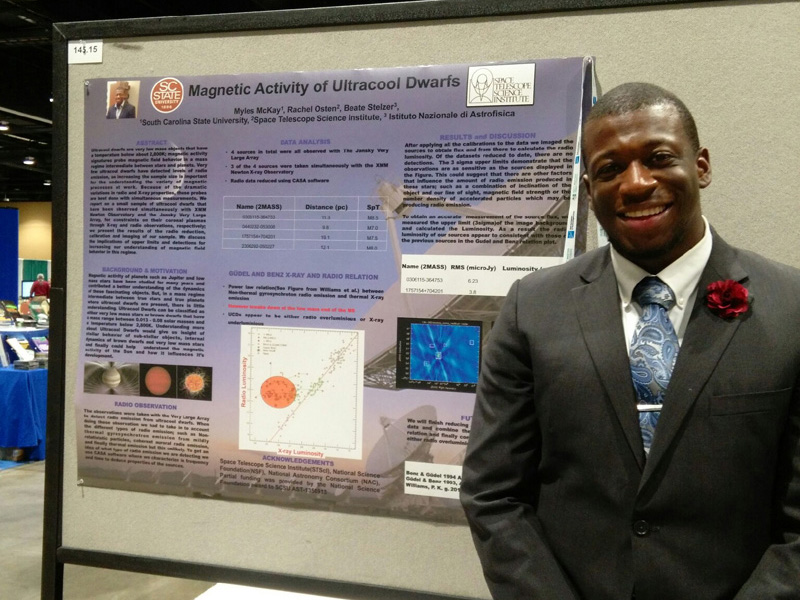 Miles McKay (South Carolina State) presented results from his NAC research program. |
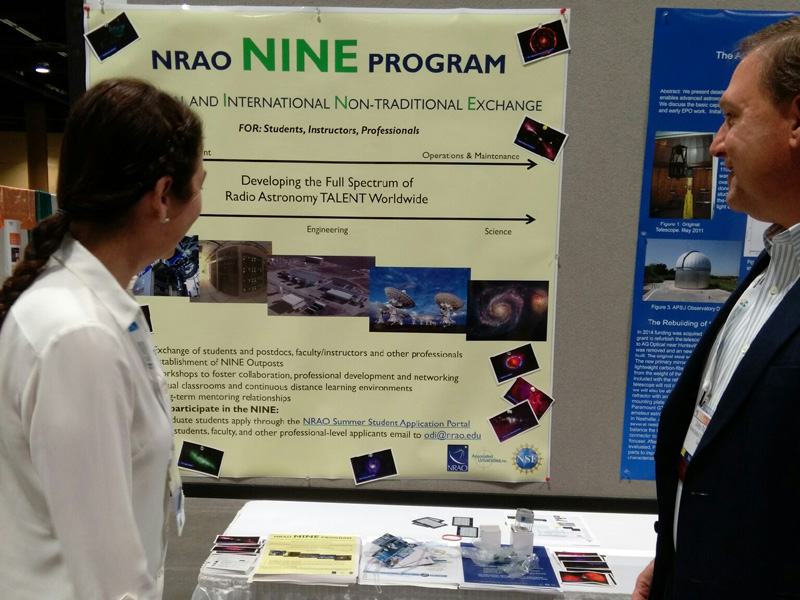 NRAO Assistant Director Lory Wingate presented a poster describing the National and International Non-traditional Exchange (NINE) program. |
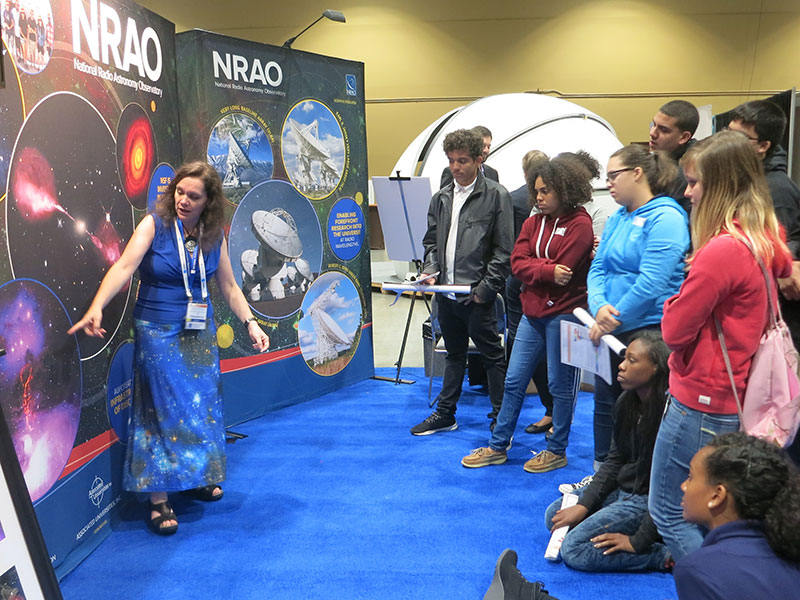 Tania Burchell interacts with one of the many Kissimmee-area student groups that visited the NRAO exhibit. |
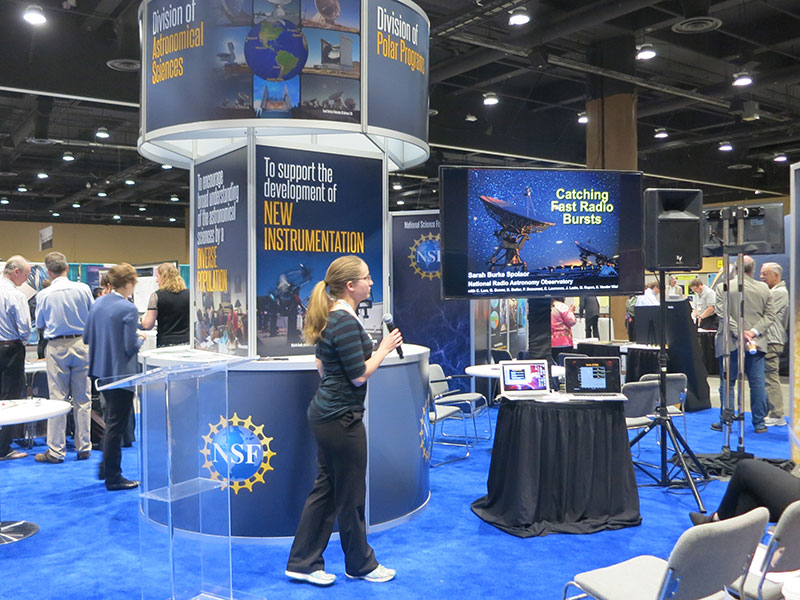 Jansky Fellow Sarah Burke-Spoloar describes her research on Fast Radio Bursts at the NSF pavilion in the exhibit hall. |
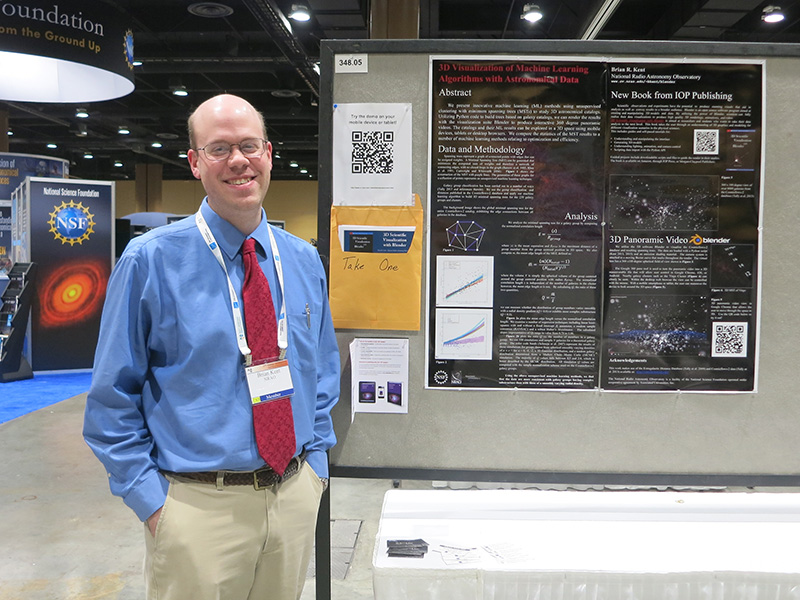 Brian Kent was one of many NRAO scientific staff who presented their most recent work. |
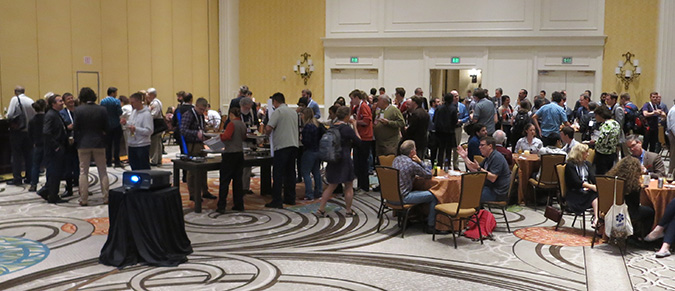 ~30% of the guests at the well-attended NRAO Town Hall. |
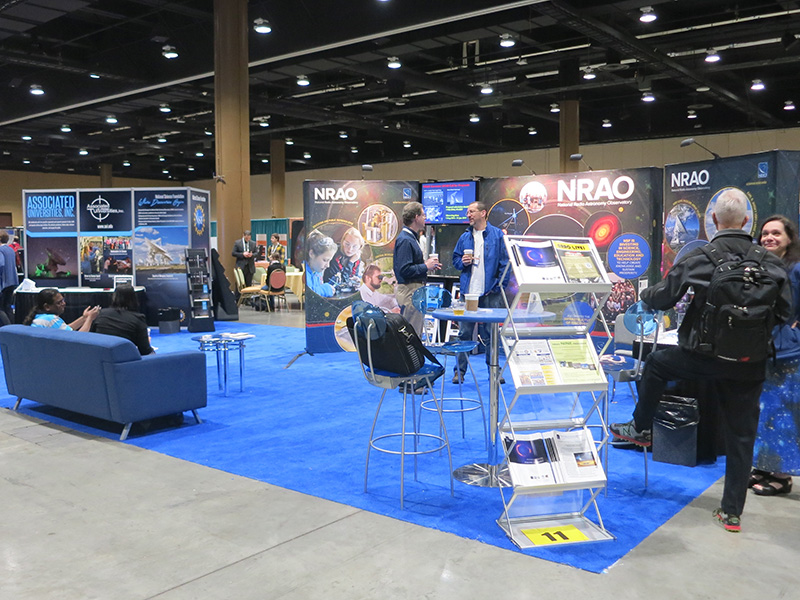 AUI (background left) and NRAO exhibits at the Kissimmee-AAS meeting. |
Robert L. Brown Outstanding Doctoral Dissertation Award
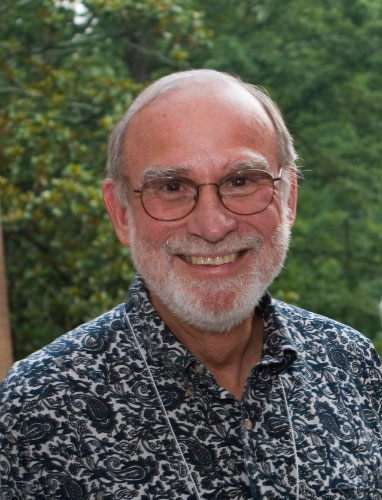
Applications for the 2015 Robert L. Brown Outstanding Doctoral Dissertation Award should be submitted to RLBrownAward@nrao.edu by 31 January 2016. This recognition of outstanding achievement by a 2015 Ph.D. recipient was established by NRAO and Associated Universities, Inc. on behalf of Bob Brown’s friends and family to honor Bob’s life and career.
For further information, please visit the Robert L. Brown Award website. Questions may be addressed to RLBrownAward@nrao.edu.
The 2016 USNC-URSI National Radio Science Meeting
The U.S. National Committee (USNC) of the International Union of Radio Science (URSI) held its annual meeting in Boulder, Colorado 6-9 January 2016. As with previous USNC-URSI meetings, the 2016 program included a wide range of subjects that were directly and indirectly relevant to radio astronomy.
The URSI Commission J (Radio Astronomy) sessions included:
- Emerging Instrumentation and Techniques
- SKA Technical Development
- Digital Developments
- New Telescopes, Techniques, and Observations
- Timing and Transients
- Atacama Large Millimeter/submillimeter Array (ALMA): Systems and Science
In addition to the numerous NRAO scientists who gave presentations during these Commission J sessions, the ALMA session featured presentations from a cross-section of scientists from the ALMA user community who braved the notoriously unpredictable Boulder weather to attend USNC-URSI.
The ALMA program featured the following speakers and presentations.
- Atacama Large Millimeter/submillimeter Array (ALMA): Status & Development
- Pierre Cox (Joint ALMA Observatory)
- The ALMA Phasing System: A New Capability for High Angular Resolution & High Sensitivity Science
- Michael Hecht (MIT Haystack Observatory)
- Observing the Sun with the ALMA: A New Tool for Solar Physics
- Timothy S. Bastian (NRAO)
- Exploring the Solar System with ALMA
- Arielle Moullet (NRAO)
- Volatiles in Protoplanetary Disks & the C/N Budgets of Terrestial Worlds
- Geoffrey Blake (Caltech)
- Witnessing the Formation of Stars & Planets with ALMA
- Laura Perez (MPIfR Bonn)
- Unraveling the Mysteries of Star & Planet Formation with ALMA
- Doug Johnstone (NRC Herzberg)
- Spectral Observations of Star Formation with ALMA
- James Di Francesco (NRC Herzberg)
- Getting the Most out of your ALMA Data with ADMIT: The ALMA Data Mining Toolkit
- Leslie Looney (University of Illinois)
- Probing Massive Star Cluster Formation with ALMA
- Kelsey Johnson (University of Virginia)
- Galaxy Evolution across Cosmic Time: The Important Role of ALMA
- Caitlin Casey (University of Texas)
- Detecting Dark Matter Subhalos with ALMA Observations of Gravitationally Lensed Galaxies
- Yashar Hezaveh (Stanford)
Commission J anticipates holding future sessions on all aspects of radio astronomy facilities and development, including next generation low- and high-frequency observatories, at its future annual meetings. We encourage all scientists and engineers interested in these subjects to attend.
Imaging ALMA From Every Angle
We often describe the Atacama Large Millimeter/submillimeter Array (ALMA) as the most complex ground-based astronomical facility ever built in one of the world’s harshest environments – but when only a handful of people spend time there, demonstrating those adjectives to the public can be a challenge.
This past December, NRAO’s Education and Public Outreach (EPO) Department sent a team to Chile for a week to film as many facets of this fully-operational astronomical gem as possible. Our goals: update the ALMA Explorer and the NRAO Public Gallery with the latest, greatest, and most unique multimedia about this facility and its environment, plus add new videos to our People series that showcases role models.
Multimedia Designer Jeff Hellerman and Animator/Illustrator Bill Saxton donned their Cameraman/Drone Pilot/Photographer/Director/Donkey Wrangler hats to brave daily 4WD adventures across the Atacama with Education Officer Sergio Cabezon and Interim EPO Director Tania Burchell. Over 8 days, and with the tremendous support of onsite staff, we filmed and photographed nearly every aspect of this incredible desert technopolis – from the control room to the cafeteria, the array to the Operations Support Facility (OSF) labs, the correlator to the gatehouse, and much more. We obtained days of footage which will require months of editing to transform into dozens of video stories about the myriad activities required to operate ALMA.
Being at ALMA is hard work but is always a pleasure because the community of people there makes it so. In between the technical location shots, we interviewed several NRAO/AUI staff about their careers to add to our collection of online role model videos and share the human aspects of radio astronomy with our audience. The passion and dedication of the ALMA staff was inspiring.
We also ventured out to capture scenes of life, past and present, in the Atacama. In San Pedro de Atacama, we met Mayoress Sandra Berna Martínez who signed a proclamation granting us the right to film in the Plaza de Armas where the renovated, no-longer-white Iglesia de San Pedro has been unveiled, and Christmas celebrations were being prepared amid throngs of international tourists. We filmed archaeological farmsteads, wandering llama and goat herds on the Salar, “astroburros” at the OSF, a geometrically-planted Tamarugo forest, sunbathing vizcachas and braying vicuñas, and the Lonely Cactus – an enormous outlier cardón which has been visited by adventuresome ALMA hikers for many years. A highlight was a visit to an ancient natural spring that supports an impressive, supremely rare, living stromatolite colony hidden deep in the high altitude desert north of the array. I could not help but find parallels between the extremophiles thriving together in that cold desert and the achievements of the ALMA partnership.
The greatest challenge of our trip to ALMA was to fly a lightweight camera drone over the array, which sits above half the Earth’s atmosphere, in freezing temperatures and blinding sunshine, and suffers unpredictable, gusty winds. No problem, right?
Click through the slides below to see highlights from the NRAO Education & Public Outreach visit to the ALMA site in December 2015.
The drone requires two operators – one to control the quadcopter’s flight, and one to control the gimballed HD camera. Bill and Jeff practiced for a month before the trip, in various settings, including the NRAO Charlottesville grounds – much to the surprise of some staff! At ALMA, they practiced again and learned that the drone could fly for fewer than 6 minutes before conditions drained its battery. We also learned that when blown off course, the drone zooms high overhead to get clear of obstacles and await landing instructions. We lost sight of the panicked ‘copter a few times and spent sweat-beading, eye-tearing seconds scanning the cold, windy, bright sky for the hovering black speck.
Despite the challenges posed by the ALMA site, Jeff and Bill’s aerial footage is breathtaking and shows ALMA’s engineering beauty in its otherworldly environment. While we work on editing polished aerial videos to share with the world, you can enjoy this teaser reel of our drone flights over ALMA.
The NRAO digital learning team is looking forward to putting together these new visual stories about ALMA to share with the world, and deeply thanks ALMA and AUI Chile staff for their support and enthusiasm.
 Bill Saxton (left) and Jeff Hellerman (right) prepare to fly the drone. |
 Jeff Hellerman imaging ALMA. |
 An archaeological site at the ALMA site. |
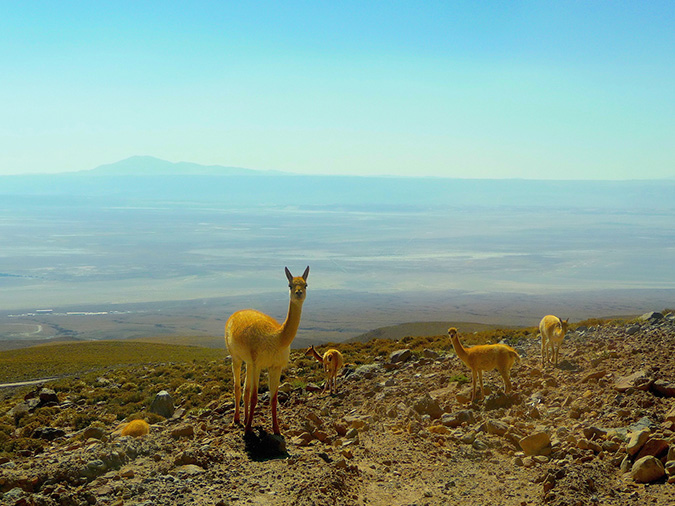 Vicuñas at the high-elevation Atacama Desert. |
 Four ALMA antennas. |
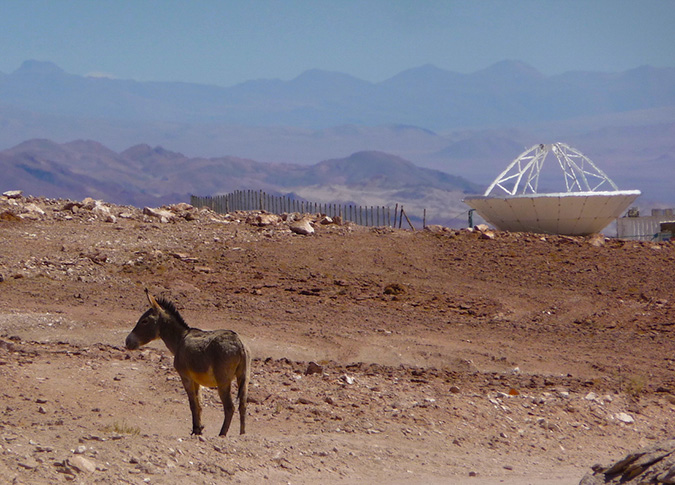 An astroburro visits ALMA. |
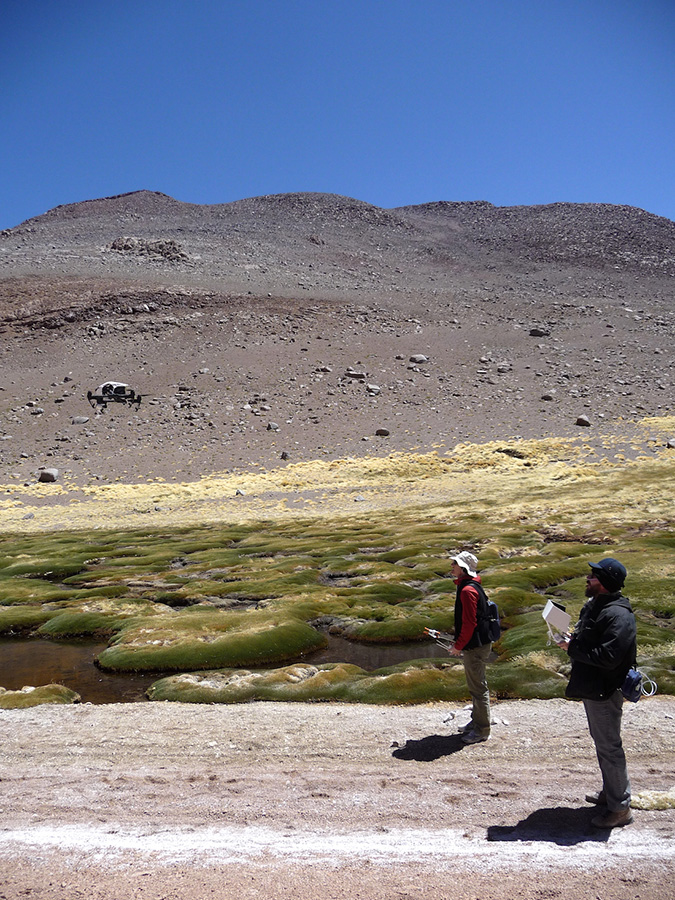 An astroburro visits ALMA. |
Recent Media Releases
Career Opportunities
Assistant Scientist/A: The NRAO is now accepting applications for an Assistant Scientist/A position for the Magdalena Ridge Observatory Interferometer (MROI) in Socorro, NM. The focus of this position is the investigation of combined optical/radio observations that could provide enhanced measurements compared to those made in a single portion of the electromagnetic spectrum. The work will be technical and will advance the state-of-the-art. The program will begin with a survey of current capabilities and will be followed by investigation of new options, including test observations with the Very Long Baseline Array and the Jansky Very Large Array.
Central Development Laboratory Director: The NRAO is accepting applications for the position of Director of the Central Development Laboratory (CDL) in Charlottesville, VA. The CDL has a long history of developing new technology to enable forefront research in radio astronomy by the scientific community. The new Director will provide the vision and leadership to continue this tradition, and to address the key technical challenges of the next generation of instruments while maintaining the performance of current NRAO facilities at the state-of-the-art.
Research Associate: The NRAO is accepting applications for the position of Research Associate in Pulsar Astrophysics, either at the Observatory headquarters in Charlottesville, VA with Scott Ransom, or at the Array Operations Center in Socorro, NM with Paul Demorest. This position is one of several postdoctoral positions that are funded through the newly established North American Nanohertz Observatory for Gravitational Waves (NANOGrav) Physics Frontier Center (PFC). The goal of the NANOGrav PFC is to detect low-frequency gravitational waves and characterize the low-frequency gravitational wave universe through radio timing observations of pulsars.
Research Associate: The NRAO invites applications for a postdoctoral researcher in galaxy evolution at the North America ALMA Science Center (NAASC) in Charlottesville, VA. The successful applicant will work under the supervision of Dr. Eric Murphy on the multi-wavelength analysis of data from the Jansky Very Large Array (VLA) Frontier Field Public Legacy Survey. The primary focus of this postdoctoral position will be incorporating new, extremely deep, sub-arcsecond, and multi-frequency (full polarization) VLA data in the Hubble Space Telescope/Spitzer Frontier Field Program.
For additional information on these openings and other NRAO career opportunities, please visit the NRAO – Career Opportunities web pages.
From the Archives
Ellen Bouton

[click to enlarge]
About this month's photograph: Construction of the Array Operations Center (AOC) in Socorro, NM, on the campus of New Mexico Tech, with M Mountain in the background. Discussions on the location of the operations and processing center for the Very Long Baseline Array (VLBA) began formally in 1983 with the appointment of a Site Selection Committee chaired by Paul Vanden Bout, then Professor of Astronomy at University of Texas, Austin. Feelings ran high, and the center's site was hotly contested: politicians, NRAO staff, and members of the astronomy community variously made the case for Green Bank, Charlottesville, Tucson, Albuquerque, Socorro, and the Plains of San Augustin. The Committee's final report, issued on 20 December 1983, recommended a common site for control of array operations and correlation of array data to be located in Socorro or Albuquerque. The Committee also stated that “it can find no necessary connection between its recommendation regarding a site for the VLBA Operations Center and the question of whether the central offices of the NRAO should move to a new site."
First construction funds for the VLBA were released on 15 May 1985, the New Mexico State Legislature appropriated funds for AOC first phase construction in early 1986 (federal funds for phase two came later), groundbreaking for the AOC occurred on 26 June 1987, and dedication was on 8 December 1988. On 30 May 2008, the Array Operations Center was officially renamed as “The Pete V. Domenici Science Operations Center” to honor retiring U.S. Senator Domenici.
From the Archives is an ongoing series illustrating NRAO and U.S. radio astronomy history via images selected from our collections of individuals' and institutional papers. If readers have images they believe would be of interest to the Archives, please contact Ellen Bouton.


